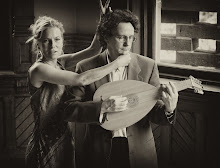
The programme notes for Saturday's concert. There'll be some blabbing too between the pieces if you want to know more. The picture is from a ceiling in Rosenborg Castle, where Danish King Christian IV lived. So, depending on when the picture was executed, maybe that lute player there is John Dowland.
See the previous post for the pieces I'll be playing, see the previous one to that to listen to an mp3 of the Ferrabosco Pavan I'll be playing.
Blame Not My Lute
The first music specifically for the lute, the most important solo and accompanying instrument in the Renaissance, appeared around the beginning of the 1500’s in Italy. That country is the centre of lute playing for the first four decades of the century and the lute style is consolidated in the works of Francesco da Milano. His oeuvre is almost entirely comprosed of Fantasias or Ricercars, that is to say, free instrumental pieces, but other Italian contemporaries based works on motets, Mass movements, madrigals and chansons, often decorating the hit vocal music of the day. By the middle of the century, though, France had become the centre of lute playing and, unsurprisingly, the country that gave us ballet increasingly chose more or less stylized dances as their favoured mode of expression. As France descended into sectarian chaos, and as England emerged from the same towards the end of the century, the latter became not just the centre of lute playing, but a net exporter of string players of all kinds. Several North European courts had an English lute player or violin band leader.
The first lute methods printed in England were translations from the French. John Dowland’s first job, at age 19, was as lutenist to the English ambassador to France. It’s natural, then, that his complete solo lute works contains about 60 dance pieces (pavans, galliards and almains, or allemandes), 7 Fancies (English for fantasia), and a few settings of popular ballad tunes. French dances dominate manuscripts and the few printed sources of lute solos as well.
Besides picking up experience with dances and lute playing while in France, Dowland also picked up Catholicism. He claimed this prevented him from ever being engaged by Elizabeth as a court lutenist, despite being the most famous instrumentalist in Europe (his works are in manuscripts from Scotland to the Ukraine). More likely he was the victim of government cutbacks at the increasingly frugal court. After a visit to Italy where he added to his compositional quiver the chromaticism and dissonance of the madrigalists Gesualdo and Marenzio, Dowland was employed by the Landgrave of Hesse and the King of Denmark, who fired him for being undependable. Back in England, a place was found for him at James I’s court, replacing a lutenist who had been dead 40 years.
Holborne appears to have been a gentleman, and it is not clear that his employment with Elizabeth was primarily as a lutenist. Apart from one song and a pavan in a collection of lute music, his printed works are for cittern solo and a collection of dances for 5-part string or wind band. It is hard to know if his lute solos in manuscripts, which are mainly versions of these 5-part pieces, are arrangements by him or someone else.
Ferrabosco was a Bolognese who was one of Elizabeth’s lutenists. He left England in a hurry when he was embroiled in the murder of one of Philip Sidney’s servants. Pilkington is known to us as a madrigal composer, though he dabbled in lute playing. Robinson published the first completely English lute method. And then there is Anon. and the nearly Anons. Whitfield and E.E. We are lucky that at least one of their works have made it through to us.


No comments:
Post a Comment